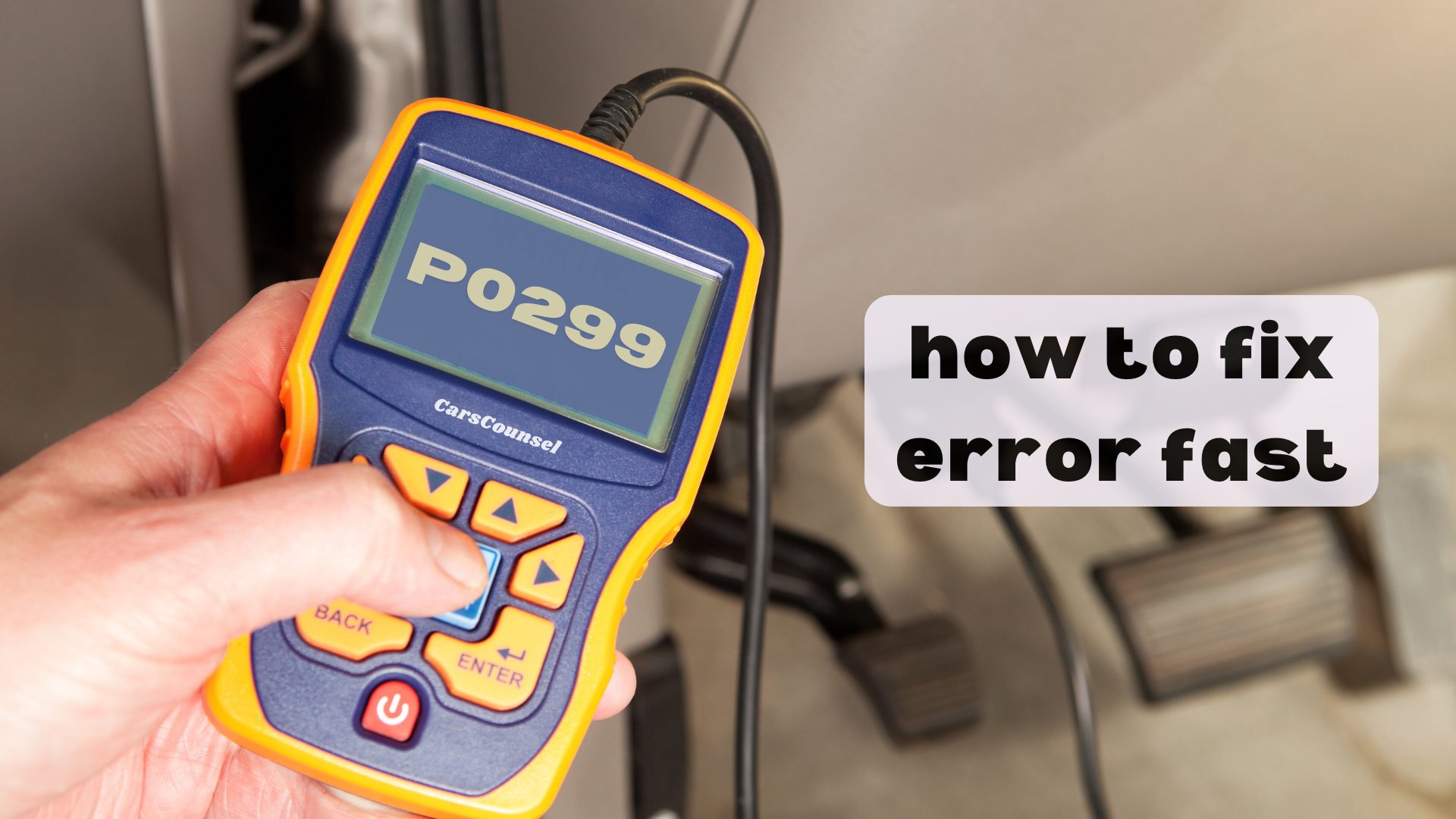When you get a P0299 code, it’s important to act quickly to avoid more engine problems.
First, confirm the error with an OBD2 scanner and then closely inspect your turbocharger system for any visible OBD2 Codes issues.
Don’t forget to check the air filter and boost sensor, as they often cause this code.
If the code still shows up after these checks, you might need more advanced fixes.
Want to know what those could be?
Let’s look into the best ways to get your vehicle running smoothly again without wasting time.

Quick Navigation
Key Takeaways
- Check the Turbocharger: Look at the turbocharger and wastegate to see if they’re worn out or damaged, and make sure they’re working right.
- Look for Leaks: Check all the hoses and pipes for any vacuum or boost pressure leaks, and fix them if needed.
- Clean or Replace the Air Filter: Make sure the air filter is clean. If it’s clogged, replace it to keep the airflow proper.
- Test the Boost Sensor: Make sure the boost sensor is giving accurate pressure readings. If it’s not, replace it.
What Is the P0299 Code
The P0299 code means your turbocharged engine isn’t getting the boost pressure it needs, which hurts its performance and power. When the engine doesn’t receive enough boost, it can’t compress air efficiently, leading to less power.
This problem can be caused by issues with the turbocharger, wastegate, or intercooler. To keep your turbocharger working well, you need to make sure all related parts are in good shape. A faulty part can limit airflow, reducing engine power and efficiency.
Knowing about the P0299 code helps you find and fix these problems quickly, so your engine runs better and avoids further damage.
Symptoms of P0299 Code
If your engine shows a P0299 code, you’ll probably notice a big drop in power, worse gas mileage, and sometimes the engine might misfire.
These issues can vary in how bad they are, but they usually have a noticeable effect on how your car runs. Your car may have trouble speeding up, especially when you need more power, and you might see it using more fuel.
Misfires can make the engine idle roughly and cause jerky movements, making driving less enjoyable.
These signs mean the turbocharger isn’t giving enough boost, which directly affects how well the engine works. Keeping an eye on these symptoms is key for catching problems early and fixing them. Ignoring them can lead to more engine damage.
Fixing the P0299 code quickly helps get your car back to running well and efficiently.
Common Causes of P0299
Common Causes of P0299
A P0299 code often pops up when the turbocharger wastegate isn’t working properly, which means it can’t control the exhaust gas pressure right. Keeping up with regular turbocharger maintenance can help prevent this by making sure the wastegate is in good shape. Another issue could be a clogged air filter, which restricts airflow and leads to underboost conditions. If the intercooler is damaged, it won’t cool the air effectively, causing the engine to overheat. Sometimes, a faulty boost sensor can give wrong pressure readings, resulting in reduced engine power. Lastly, an old turbocharger might need fixing or replacing to keep everything running smoothly and to avoid the P0299 code.
| Common Cause | Description |
|---|---|
| Faulty Turbocharger Wastegate | Can’t control exhaust gas pressure properly. |
| Clogged Air Filter | Restricts airflow, leading to underboost. |
| Damaged Intercooler | Poor cooling causes engine to overheat. |
| Malfunctioning Boost Sensor | Gives wrong pressure readings. |
| Aging Turbocharger | Might need repair or replacement. |
Affected Car Models
The P0299 code often shows up in certain car models, especially those with turbocharged engines, so it’s important to know which vehicles are more likely to have this problem.
Volkswagen Jetta models from 2004 to 2015 often have issues with the turbocharger wastegate, which affects how well the turbocharger works.
Ford F-150 trucks from 2011 to 2016 have been known to have problems with their intercoolers, causing this code to appear.
The BMW 335i, made between 2008 and 2013, often has failures in its high-pressure fuel pump that affect engine boost.
Dodge Ram 2500/3500 models from 2007 to 2012 can have issues with the EGR valve, which affects vehicle emissions.
While these models are more likely to see the P0299 code, it can show up in any vehicle with a turbocharged or boosted engine, so timely diagnostics and repairs are necessary.
Diagnosing P0299 Issues
To diagnose P0299 problems, start by using an OBD2 scanner to read the error code. Make sure you have the right tools.
Begin with a visual check of the turbo system, looking for any obvious damage or leaks in the hoses and intercooler.
Next, do a pressure test on the turbocharger or compressor to find any leaks or performance issues.
Also, check if the EGR valve is working properly, as it could be part of the problem.
Taking the car for a detailed test drive can help spot related symptoms like loss of power or poor fuel efficiency.
Using OBD2 Scanner
An OBD2 scanner is a must-have tool for reading and understanding the P0299 code, which helps you find the cause of turbocharger underboost problems. Knowing the basics of an OBD2 scanner is important.
Connect the scanner to the vehicle’s OBD2 port, usually found under the dashboard. Turn the ignition on, and follow the scanner’s instructions to get the error codes.
An OBD2 scanner has many benefits: it gives real-time data, identifies specific fault codes, and provides freeze frame data for better diagnostics.
Using an OBD2 scanner lets you quickly diagnose the P0299 code, saving time and avoiding unnecessary repairs. This tool ensures you fix the right part, making your troubleshooting more accurate.
Visual Inspection Steps
Start by looking over the turbocharger and its related parts for any obvious signs of wear, damage, or leaks. Pay close attention to parts like the compressor housing, turbine housing, and wastegate. Check for cracks, oil leaks, or loose connections that might affect how well the turbocharger works.
| Component | What to Look For |
|---|---|
| Turbocharger | Cracks or damage |
| Hoses and Piping | Leaks or wear |
| Intercooler | Oil residue |
Make sure all hoses are tightly connected and have no splits or bulges. Check the intercooler for any oil, which could mean the turbo seal is failing. This thorough visual check will help you find potential problems quickly and accurately.
Fixing P0299 Code
After you’ve done a visual check, you should fix the P0299 code by focusing on parts that usually cause low boost.
Start by looking at the turbocharger: make sure the wastegate works right and fix or replace it if needed.
Then, check the air filter and clean or replace it to ensure good airflow.
Look at the boost sensor to see if it’s reading pressure correctly and change it if it’s not.
Examine the intercooler for any damage or leaks, and repair or replace it to keep it cooling well.
If the EGR valve isn’t working right, clean it or get a new one to help the engine run better.
Lastly, regularly check for leaks in hoses and connections to avoid future low boost problems.
Safety Concerns
Driving with the P0299 code can really hurt how your engine works and make your vehicle less safe, so you need to deal with it right away. A faulty turbocharger can make the engine unreliable and might cause sudden power loss, increasing the chance of accidents. Plus, higher emissions from your car can get you fined and harm the environment.
| Safety Concern | Impact |
|---|---|
| Engine Performance | Less power and efficiency |
| Vehicle Handling | Reduced safety while driving |
| Emission Compliance | Higher emissions, potential fines |
Fixing the P0299 code quickly helps keep your car running well and within emission limits. If you ignore it, you could end up with bigger engine problems, expensive repairs, and even legal trouble. Make sure to get your vehicle checked and repaired in a timely manner to keep it safe and reliable.
Repair Costs
Taking care of the P0299 code quickly isn’t just about staying safe; it’s also about controlling repair costs.
Start by getting an accurate estimate. Fixing a damaged intercooler can cost between $500 and $1000, while repairing a faulty EGR valve is usually around $300. Turbocharger repairs or replacements are pricier, often over $1500.
Don’t forget that labor and diagnostic fees will add to these costs, so it’s important to get a detailed quote from your mechanic. Planning for these possible expenses can help you avoid financial surprises and keep your car in good shape.
Regular maintenance, like changing air filters and checking the EGR valve, can help prevent bigger, more expensive problems.
More OBD-II Codes
Frequently Asked Questions
Can a P0299 Code Affect Fuel Efficiency Long-Term?
Yes, a P0299 code can affect fuel efficiency over time. You’ll use more fuel because the turbo isn’t working properly, making the engine run less efficiently. It’s important to fix the problem quickly.
How Often Should Turbo System Maintenance Be Performed?
Think of your turbo system like a marathon runner; regular check-ups keep it running its best. You should follow what the manufacturer suggests, usually every 30,000 miles, and make sure to inspect the turbo system thoroughly for top performance.
What Tools Are Needed for DIY Diagnostics of P0299?
To diagnose P0299, you’ll need an OBD2 scanner, a pressure tester, and basic tools for looking over parts. These tools help you find leaks, check how well the turbocharger is working, and make sure the sensors are reading correctly.
Are There Any Software Updates That Address P0299 Issues?
You should ask your car’s manufacturer if there are any software updates or diagnostic tools available. These updates might help fix P0299 problems by adjusting the engine control unit (ECU) to improve turbocharger performance and boost pressure readings.
Can Aftermarket Parts Cause a P0299 Code to Appear?
Yes, using aftermarket parts can cause a P0299 code if they aren’t reliable or don’t work well with your turbocharger. Make sure all aftermarket parts match your vehicle’s specs to avoid underboost problems and keep your car running well.
Conclusion
Think of your car’s turbocharger as the key to its performance. When the P0299 code shows up, it’s a signal that something’s wrong.
To fix it, start by using an OBD2 scanner, check for leaks, and make sure air is flowing properly. Each step you take will help resolve the issue.
Once done, clear the code, take your car for a test drive, and let it run smoothly again.
Safety and careful work are essential.

